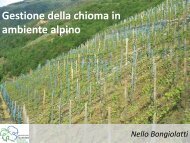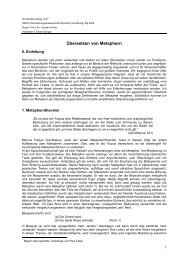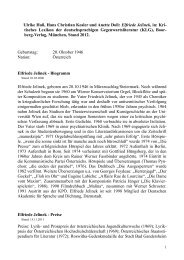Volume of Abstracts - Università degli Studi di Milano
Volume of Abstracts - Università degli Studi di Milano
Volume of Abstracts - Università degli Studi di Milano
Create successful ePaper yourself
Turn your PDF publications into a flip-book with our unique Google optimized e-Paper software.
5 th Int. Workshop on Ice Caves (IWIC – V)<br />
Barzio (LC), Valsassina, Grigna and <strong>Milano</strong>, September 16 – 23, 2012<br />
<strong>Volume</strong> <strong>of</strong> <strong>Abstracts</strong><br />
The formation <strong>of</strong> huge contact caves as a prelude to dramatic breaking<br />
down and subsequent rapid evolution <strong>of</strong> the snout has been reported also<br />
on other alpine glaciers, such as the Scalino Glacier and Vedretta <strong>di</strong> Fellaria<br />
(both in Valmalenco, Northern Italy) or Gorner Glacier (Southern<br />
Switzerland). It therefore evident that contact glacial caves at the snout<br />
play a significant role in the evolution <strong>of</strong> the snout itself, thus being<br />
responsible for rapid and spectacular retreats: information given by the<br />
study <strong>of</strong> endo-and subglacial caves may thus help in forecasting glacier<br />
evolution in the very next future.<br />
GLACIAL CAVES OF THE BELLINGSHAUSEN DOME AND ADJACENT<br />
AREAS, KING GEORGE ISLAND, SOUTH SHETLAND ISLANDS,<br />
ANTARCTICA<br />
Mavlyudov B.R. 1<br />
1 Institute <strong>of</strong> geography RAS, Staromonetny 29, Moscow, 119017, Russia<br />
Researches during summer seasons <strong>of</strong> 2007-2012 at Bellingshausen Dome<br />
have shown presence <strong>of</strong> glacial caves <strong>of</strong> 4 types: 1) usual; 2) the buried<br />
ice canyons; 3) in a shadow <strong>of</strong> rocky ledges; 4) marine. Usual glacial caves<br />
meet within the limits <strong>of</strong> glaciers <strong>of</strong> Island very seldom as here con<strong>di</strong>tions<br />
for their formation very <strong>of</strong>ten are not observed (not present crevasses and<br />
there is no internal drainage or on the contrary many crevasses and there<br />
is no sufficient concentration <strong>of</strong> water streams for cavities origin).<br />
Therefore moulins here are not usually formed, but it is possible to meet<br />
glacial caves at the places <strong>of</strong> water outputs on a surface. All observed<br />
caves were englacial. Such caves have been met in the western part <strong>of</strong> the<br />
Dome and outside <strong>of</strong> the Dome near to its northern boundary. Separately<br />
stay cave which is formed under nunatak in northern part <strong>of</strong> a glacial dome<br />
which has been generated by melt water which got warm at their current<br />
on a rocky surface <strong>of</strong> nunatak up to 6°С. Length <strong>of</strong> the investigated cavity<br />
was about 70 m. The buried ice canyons are enough widely widespread and<br />
basically they are formed where the concentrated stream <strong>of</strong> melt water<br />
from the Dome flows along a moraine surroun<strong>di</strong>ng the Dome on perimeter.<br />
Permanent lowering <strong>of</strong> ice surface conducts to occurrence <strong>of</strong> the new ice<br />
canyons which are settling down further from boundary <strong>of</strong> glacier. The<br />
canyons abandoned by water are closed by snow, ice and moraine<br />
se<strong>di</strong>ments forming glacial caves. There are canyons from several meters up<br />
to 15 m depth in southern, western and northern parts <strong>of</strong> the Dome. All<br />
founded moulins was connected with the buried canyons. Cavities in a<br />
shadow <strong>of</strong> rocky ledges are formed apparently everywhere in places where<br />
24

















